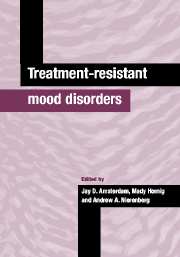Book contents
- Frontmatter
- Contents
- List of contributors
- Preface
- Part I The clinical problem
- Part II Biological basis
- 3 Psychoneuroendocrine aspects of treatment-resistant mood disorders
- 4 Estrogen and depressive illness in women
- 5 Sleep abnormalities in treatment-resistant mood disorders
- 6 Structural and functional brain imaging in treatment-resistant depression
- 7 Immunologic factors in treatment-resistant depression
- Part III Treatment approaches
- Part IV Special patient populations
- Part V Economic and ethical issues
- Index
- Plate Section
5 - Sleep abnormalities in treatment-resistant mood disorders
from Part II - Biological basis
Published online by Cambridge University Press: 25 March 2010
- Frontmatter
- Contents
- List of contributors
- Preface
- Part I The clinical problem
- Part II Biological basis
- 3 Psychoneuroendocrine aspects of treatment-resistant mood disorders
- 4 Estrogen and depressive illness in women
- 5 Sleep abnormalities in treatment-resistant mood disorders
- 6 Structural and functional brain imaging in treatment-resistant depression
- 7 Immunologic factors in treatment-resistant depression
- Part III Treatment approaches
- Part IV Special patient populations
- Part V Economic and ethical issues
- Index
- Plate Section
Summary
Oh Sleep! It is a gentle thing,
Beloved from pole to pole …
Samuel Taylor ColeridgeThe close inter-relationship between mood and sleep, has led some to suggest that sleep-wake cycle alterations are central to these disorders (Goodwin & Jamieson, 1990). In this chapter, we will review the existing literature on the relationship between sleep and mood disorders, in particular, treatment-resistant disorders.
(i) We will begin by reviewing the subjective and objective changes in sleep that occur in depressive and manic episodes and describe how these sleep findings may be predictive of treatment-resistant states.
(ii) We will then go on to describe the various manipulations, either deliberate or accidental, of the sleep–wake cycle which can either improve treatment-resistant depressive states, or conversely, contribute to treatment-resistant manic states.
(iii) We will then discuss the relationship between primary sleep disorders and treatment-resistant mood states.
Normal Sleep
Normal sleep consists of alternating REM (rapid eye movement) and non-REM epochs. Non-REM sleep is divided into four stages. During Stages 1 and 2, individuals are easily awakened and can be partially aware of environmental events, such as someone entering the room. Thus, a person in these shallower stages, though asleep, may experience himself or herself as being awake. In contrast, the arousal threshold for Stages 3 and 4 (delta) sleep is much higher. Data suggest that this deeper sleep is the restorative period of the sleep cycle. Thus, in the absence of adequate delta sleep, one awakens feeling tired and unrefreshed.
The electroencephalographic characteristics of REM sleep bears similarities to Stage 1 and the waking stage, being predominated by low voltage, fast activity.
Keywords
- Type
- Chapter
- Information
- Treatment-Resistant Mood Disorders , pp. 96 - 110Publisher: Cambridge University PressPrint publication year: 2001
- 3
- Cited by



